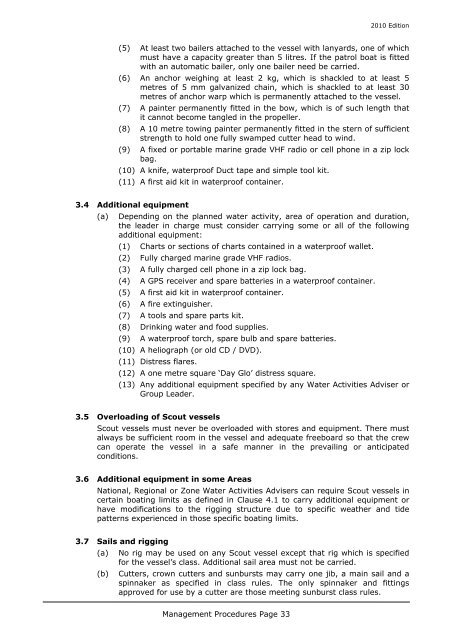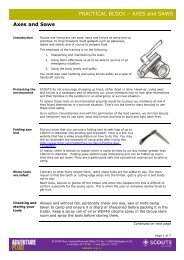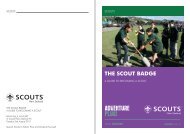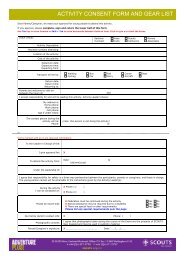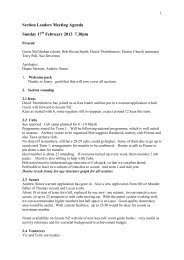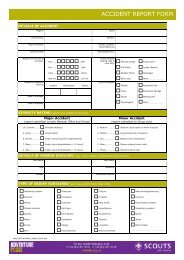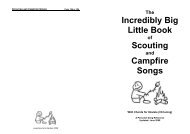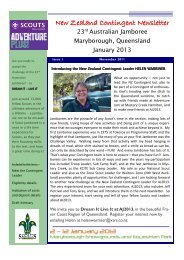The_Rule_Book - Brooklyn Scouts, Wellington
The_Rule_Book - Brooklyn Scouts, Wellington
The_Rule_Book - Brooklyn Scouts, Wellington
You also want an ePaper? Increase the reach of your titles
YUMPU automatically turns print PDFs into web optimized ePapers that Google loves.
2010 Edition<br />
(5) At least two bailers attached to the vessel with lanyards, one of which<br />
must have a capacity greater than 5 litres. If the patrol boat is fitted<br />
with an automatic bailer, only one bailer need be carried.<br />
(6) An anchor weighing at least 2 kg, which is shackled to at least 5<br />
metres of 5 mm galvanized chain, which is shackled to at least 30<br />
metres of anchor warp which is permanently attached to the vessel.<br />
(7) A painter permanently fitted in the bow, which is of such length that<br />
it cannot become tangled in the propeller.<br />
(8) A 10 metre towing painter permanently fitted in the stern of sufficient<br />
strength to hold one fully swamped cutter head to wind.<br />
(9) A fixed or portable marine grade VHF radio or cell phone in a zip lock<br />
bag.<br />
(10) A knife, waterproof Duct tape and simple tool kit.<br />
(11) A first aid kit in waterproof container.<br />
3.4 Additional equipment<br />
(a) Depending on the planned water activity, area of operation and duration,<br />
the leader in charge must consider carrying some or all of the following<br />
additional equipment:<br />
(1) Charts or sections of charts contained in a waterproof wallet.<br />
(2) Fully charged marine grade VHF radios.<br />
(3) A fully charged cell phone in a zip lock bag.<br />
(4) A GPS receiver and spare batteries in a waterproof container.<br />
(5) A first aid kit in waterproof container.<br />
(6) A fire extinguisher.<br />
(7) A tools and spare parts kit.<br />
(8) Drinking water and food supplies.<br />
(9) A waterproof torch, spare bulb and spare batteries.<br />
(10) A heliograph (or old CD / DVD).<br />
(11) Distress flares.<br />
(12) A one metre square ‘Day Glo’ distress square.<br />
(13) Any additional equipment specified by any Water Activities Adviser or<br />
Group Leader.<br />
3.5 Overloading of Scout vessels<br />
Scout vessels must never be overloaded with stores and equipment. <strong>The</strong>re must<br />
always be sufficient room in the vessel and adequate freeboard so that the crew<br />
can operate the vessel in a safe manner in the prevailing or anticipated<br />
conditions.<br />
3.6 Additional equipment in some Areas<br />
National, Regional or Zone Water Activities Advisers can require Scout vessels in<br />
certain boating limits as defined in Clause 4.1 to carry additional equipment or<br />
have modifications to the rigging structure due to specific weather and tide<br />
patterns experienced in those specific boating limits.<br />
3.7 Sails and rigging<br />
(a) No rig may be used on any Scout vessel except that rig which is specified<br />
for the vessel’s class. Additional sail area must not be carried.<br />
(b) Cutters, crown cutters and sunbursts may carry one jib, a main sail and a<br />
spinnaker as specified in class rules. <strong>The</strong> only spinnaker and fittings<br />
approved for use by a cutter are those meeting sunburst class rules.<br />
Management Procedures Page 33


